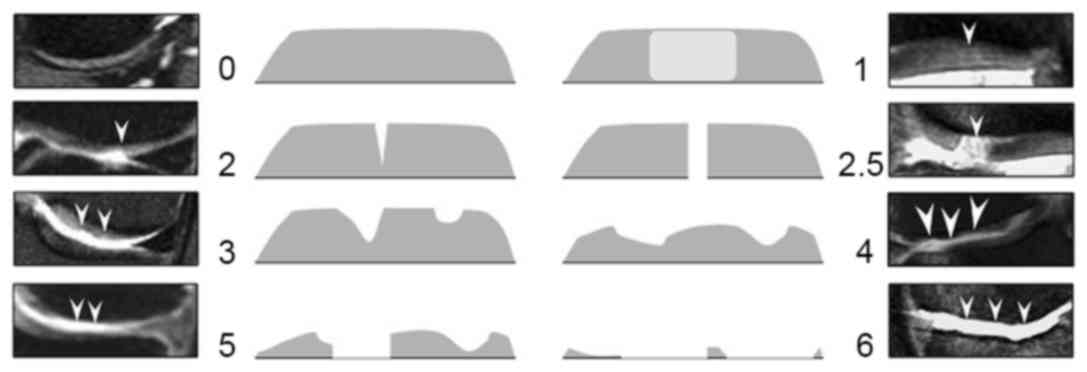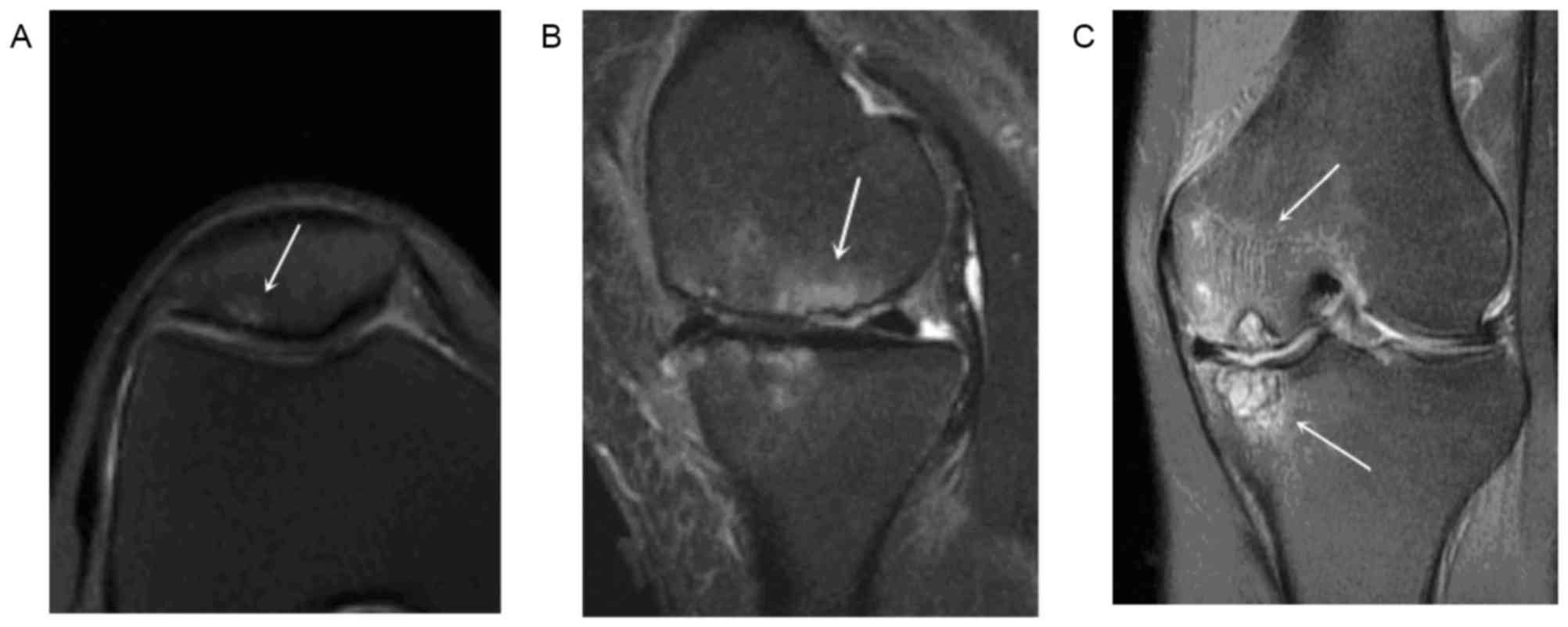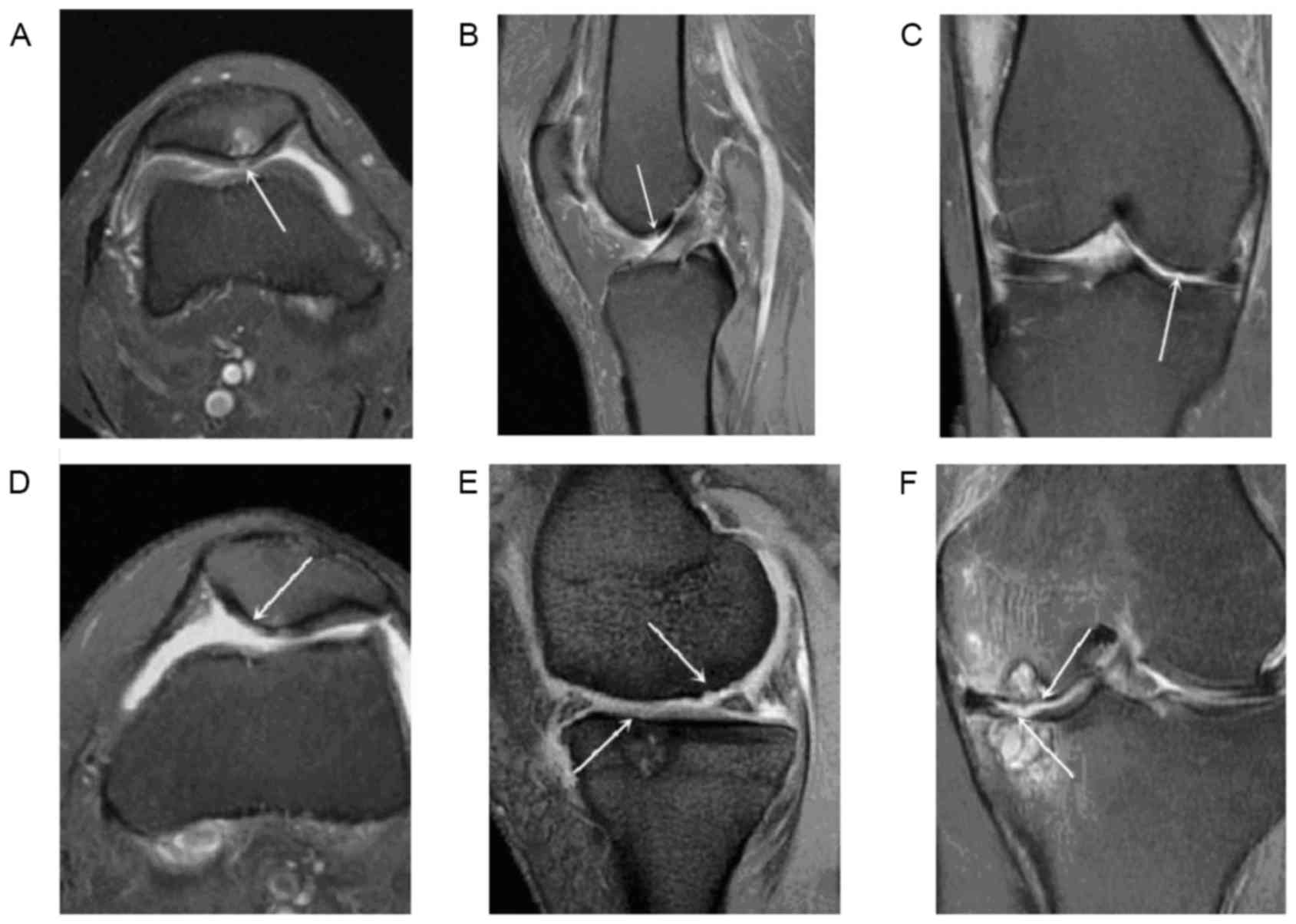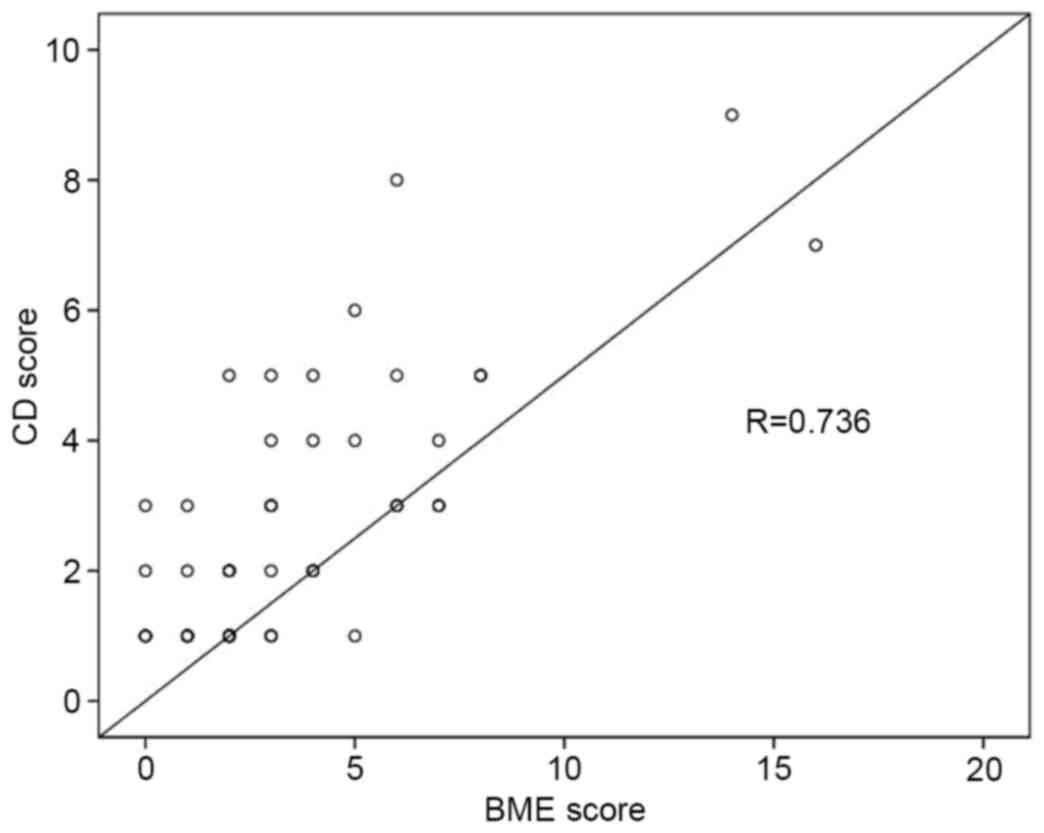|
1
|
Guermazi A, Niu J, Hayashi D, Roemer FW,
Englund M, Neogi T, Aliabadi P, McLennan CE and Felson DT:
Prevalence of abnormalities in knees detected by MRI in adults
without knee osteoarthritis: Population based observational study
(Framingham Osteoarthritis Study). BMJ. 345:e53392012. View Article : Google Scholar : PubMed/NCBI
|
|
2
|
Crema MD, Guermazi A, Sayre EC, Roemer FW,
Wong H, Thorne A, Singer J, Esdaile JM, Marra MD, Kopec JA, et al:
The association of magnetic resonance imaging (MRI)-detected
structural pathology of the knee with crepitus in a
population-based cohort with knee pain: The MoDEKO study.
Osteoarthritis Cartilage. 19:1429–1432. 2011. View Article : Google Scholar : PubMed/NCBI
|
|
3
|
Bedson J and Croft PR: The discordance
between clinical and radiographic knee osteoarthritis: A systematic
search and summary of the literature. BMC Musculoskelet Disord.
9:1162008. View Article : Google Scholar : PubMed/NCBI
|
|
4
|
Amin S, LaValley MP, Guermazi A, Grigoryan
M, Hunter DJ, Clancy M, Niu J, Gale DR and Felson DT: The
relationship between cartilage loss on magnetic resonance imaging
and radiographic progression in men and women with knee
osteoarthritis. Arthritis Rheum. 52:3152–3159. 2005. View Article : Google Scholar : PubMed/NCBI
|
|
5
|
Sowers M, Karvonen-Gutierrez CA, Jacobson
JA, Jiang Y and Yosef M: Associations of anatomical measures from
MRI with radiographically defined knee osteoarthritis score, pain,
and physical functioning. J Bone Joint Surg Am. 93:241–251. 2011.
View Article : Google Scholar : PubMed/NCBI
|
|
6
|
Guermazi A, Roemer FW and Hayashi D:
Imaging of osteoarthritis: Update from a radiological perspective.
Curr Opin Rheumatol. 23:484–491. 2011. View Article : Google Scholar : PubMed/NCBI
|
|
7
|
Farrokhi S, Piva SR, Gil AB, Oddis CV,
Brooks MM and Fitzgerald GK: Association of severity of coexisting
patellofemoral disease with increased impairments and functional
limitations in patients with knee osteoarthritis. Arthritis Care
Res (Hoboken). 65:544–551. 2013. View Article : Google Scholar : PubMed/NCBI
|
|
8
|
Stefanik JJ, Niu J, Gross KD, Roemer FW,
Guermazi A and Felson DT: Using magnetic resonance imaging to
determine the compartmental prevalence of knee joint structural
damage. Osteoarthritis Cartilage. 21:695–699. 2013. View Article : Google Scholar : PubMed/NCBI
|
|
9
|
Duncan R, Peat G, Thomas E, Wood L, Hay E
and Croft P: Does isolated patellofemoral osteoarthritis matter?
Osteoarthritis Cartilage. 17:1151–1155. 2009. View Article : Google Scholar : PubMed/NCBI
|
|
10
|
Stefanik JJ, Neogi T, Niu J, Roemer FW,
Segal NA, Lewis CE, Nevitt M, Guermazi A and Felson DT: The
diagnostic performance of anterior knee pain and activity-related
pain in identifying knees with structural damage in the
patellofemoral joint: The multicenter osteoarthritis study. J
Rheumatol. 41:1695–1702. 2014. View Article : Google Scholar : PubMed/NCBI
|
|
11
|
Singh AK, Kalaivani M, Krishnan A,
Aggarwal PK and Gupta SK: Prevalence of osteoarthritis of knee
among elderly persons in urban slums using American college of
rheumatology (ACR) criteria. J Clin Diagn Res. 8:JC09–JC11.
2014.PubMed/NCBI
|
|
12
|
Peterfy CG, Guermazi A, Zaim S, Tirman PF,
Miaux Y, White D, Kothari M, Lu Y, Fye K, Zhao S and Genant HK:
Whole-organ magnetic resonance imaging score (WORMS) of the knee in
osteoarthritis. Osteoarthritis Cartilage. 12:177–190. 2004.
View Article : Google Scholar : PubMed/NCBI
|
|
13
|
Hayashi D, Felson DT, Niu J, Hunter DJ,
Roemer FW, Aliabadi P and Guermazi A: Pre-radiographic
osteoarthritic changes are highly prevalent in the medial patella
and medial posterior femur in older persons: Framingham OA study.
Osteoarthritis Cartilage. 22:76–83. 2014. View Article : Google Scholar : PubMed/NCBI
|
|
14
|
Duncan RC, Hay EM, Saklatvala J and Croft
PR: Prevalence of radiographic osteoarthritis-it all depends on
your point of view. Rheumatology (Oxford). 45:757–760. 2006.
View Article : Google Scholar : PubMed/NCBI
|
|
15
|
Duncan R, Peat G, Thomas E, Wood L, Hay E
and Croft P: How do pain and function vary with compartmental
distribution and severity of radiographic knee osteoarthritis?
Rheumatology (Oxford). 47:1704–1707. 2008. View Article : Google Scholar : PubMed/NCBI
|
|
16
|
Amin S, Baker K, Niu J, Clancy M, Goggins
J, Guermazi A, Grigoryan M, Hunter DJ and Felson DT: Quadriceps
strength and the risk of cartilage loss and symptom progression in
knee osteoarthritis. Arthritis Rheum. 60:189–198. 2009. View Article : Google Scholar : PubMed/NCBI
|
|
17
|
Youssef Rehan A, Longino D, Seerattan R,
Leonard T and Herzog W: Muscle weakness causes joint degeneration
in rabbits. Osteoarthritis Cartilage. 17:1228–1235. 2009.
View Article : Google Scholar : PubMed/NCBI
|
|
18
|
Szebenyi B, Hollander AP, Dieppe P, Quilty
B, Duddy J, Clarke S and Kirwan JR: Associations between pain,
function, and radiographic features in osteoarthritis of the knee.
Arthritis Rheum. 54:230–235. 2006. View Article : Google Scholar : PubMed/NCBI
|
|
19
|
Hunter DJ, Zhang Y, Niu J, Goggins J, Amin
S, LaValley MP, Guermazi A, Genant H, Gale D and Felson DT:
Increase in bone marrow lesions associated with cartilage loss: A
longitudinal magnetic resonance imaging study of knee
osteoarthritis. Arthritis Rheum. 54:1529–1535. 2006. View Article : Google Scholar : PubMed/NCBI
|
|
20
|
Peat G, Duncan RC, Wood LR, Thomas E and
Muller S: Clinical features of symptomatic patellofemoral joint
osteoarthritis. Arthritis Res Ther. 14:R632012. View Article : Google Scholar : PubMed/NCBI
|
|
21
|
van Eijden TM, Kouwenhoven E, Verburg J
and Weijs WA: A mathematical model of the patellofemoral joint. J
Biomech. 19:219–229. 1986. View Article : Google Scholar : PubMed/NCBI
|
|
22
|
Reilly DT and Martens M: Experimental
analysis of the quadriceps muscle force and patello-femoral joint
reaction force for various activities. Acta Orthop Scand.
43:126–137. 1972. View Article : Google Scholar : PubMed/NCBI
|
|
23
|
Froimson MI, Ratcliffe A, Gardner TR and
Mow VC: Differences in patellofemoral joint cartilage material
properties and their significance to the etiology of cartilage
surface fibrillation. Osteoarthritis Cartilage. 5:377–386. 1997.
View Article : Google Scholar : PubMed/NCBI
|
|
24
|
Mansuripur PK, Deren ME, Hayda R and Born
CT: Initial management of ankle fractures in the overweight and
obese: The providence pinch. J Emerg Med. 47:561–564. 2014.
View Article : Google Scholar : PubMed/NCBI
|
|
25
|
Gudbergsen H, Lohmander LS, Jones G,
Christensen R, Bartels EM, Danneskiold-Samsøe B, Bliddal H and
Boesen M: Correlations between radiographic assessments and MRI
features of knee osteoarthritis-a cross-sectional study.
Osteoarthritis Cartilage. 21:535–543. 2013. View Article : Google Scholar : PubMed/NCBI
|
|
26
|
Novais EN and Millis MB: Slipped capital
femoral epiphysis: Prevalence, pathogenesis, and natural history.
Clin Orthop Relat Res. 470:3432–3438. 2012. View Article : Google Scholar : PubMed/NCBI
|
|
27
|
Felson DT: Osteoarthritis as a disease of
mechanics. Osteoarthritis Cartilage. 21:10–15. 2013. View Article : Google Scholar : PubMed/NCBI
|
|
28
|
Ulrich-Vinther M, Maloney MD, Schwarz EM,
Rosier R and O'Keefe RJ: Articular cartilage biology. J Am Acad
Orthop Surg. 11:421–430. 2003. View Article : Google Scholar : PubMed/NCBI
|
|
29
|
Benichou OD, Hunter DJ, Nelson DR,
Guermazi A, Eckstein F, Kwoh K, Myers SL, Wirth W and Duryea J:
Osteoarthritis Initiative Investigators: One-year change in
radiographic joint space width in patients with unilateral joint
space narrowing: Data from the Osteoarthritis Initiative. Arthritis
Care Res (Hoboken). 62:924–931. 2010. View Article : Google Scholar : PubMed/NCBI
|
|
30
|
Spector TD, Hart DJ, Byrne J, Harris PA,
Dacre JE and Doyle DV: Definition of osteoarthritis of the knee for
epidemiological studies. Ann Rheum Dis. 52:790–794. 1993.
View Article : Google Scholar : PubMed/NCBI
|
|
31
|
Link TM, Steinbach LS, Ghosh S, Ries M, Lu
Y, Lane N and Majumdar S: Osteoarthritis: MR imaging findings in
different stages of disease and correlation with clinical findings.
Radiology. 226:373–381. 2003. View Article : Google Scholar : PubMed/NCBI
|
|
32
|
Baranyay FJ, Wang Y, Wluka AE, English DR,
Giles GG, Sullivan RO and Cicuttini FM: Association of bone marrow
lesions with knee structures and risk factors for bone marrow
lesions in the knees of clinically healthy, community-based adults.
Semin Arthritis Rheum. 37:112–118. 2007. View Article : Google Scholar : PubMed/NCBI
|
|
33
|
Felson DT, McLaughlin S, Goggins J,
LaValley MP, Gale ME, Totterman S, Li W, Hill C and Gale D: Bone
marrow edema and its relation to progression of knee
osteoarthritis. Ann Intern Med. 139:330–336. 2003. View Article : Google Scholar : PubMed/NCBI
|
|
34
|
Roemer FW, Guermazi A, Javaid MK, Lynch
JA, Niu J, Zhang Y, Felson DT, Lewis CE, Torner J and Nevitt MC:
MOST Study investigators: Change in MRI-detected subchondral bone
marrow lesions is associated with cartilage loss: The MOST Study. A
longitudinal multicentre study of knee osteoarthritis. Ann Rheum
Dis. 68:1461–1465. 2009. View Article : Google Scholar : PubMed/NCBI
|
|
35
|
Bellamy N: The WOMAC knee and hip
osteoarthritis indices: Development, validation, globalization and
influence on the development of the AUSCAN hand osteoarthritis
indices. Clin Exp Rheumatol. 23:(5 Suppl 39). S148–S153.
2005.PubMed/NCBI
|
|
36
|
Hanna FS, Bell RJ, Davis SR, Wluka AE,
Teichtahl AJ, O'Sullivan R and Cicuttini FM: Factors affecting
patella cartilage and bone in middle-aged women. Arthritis Rheum.
57:272–278. 2007. View Article : Google Scholar : PubMed/NCBI
|
|
37
|
Teichtahl AJ, Wluka AE, Proietto J and
Cicuttini FM: Obesity and the female sex, risk factors for knee
osteoarthritis that may be attributable to systemic or local leptin
biosynthesis and its cellular effects. Med Hypotheses. 65:312–315.
2005. View Article : Google Scholar : PubMed/NCBI
|













